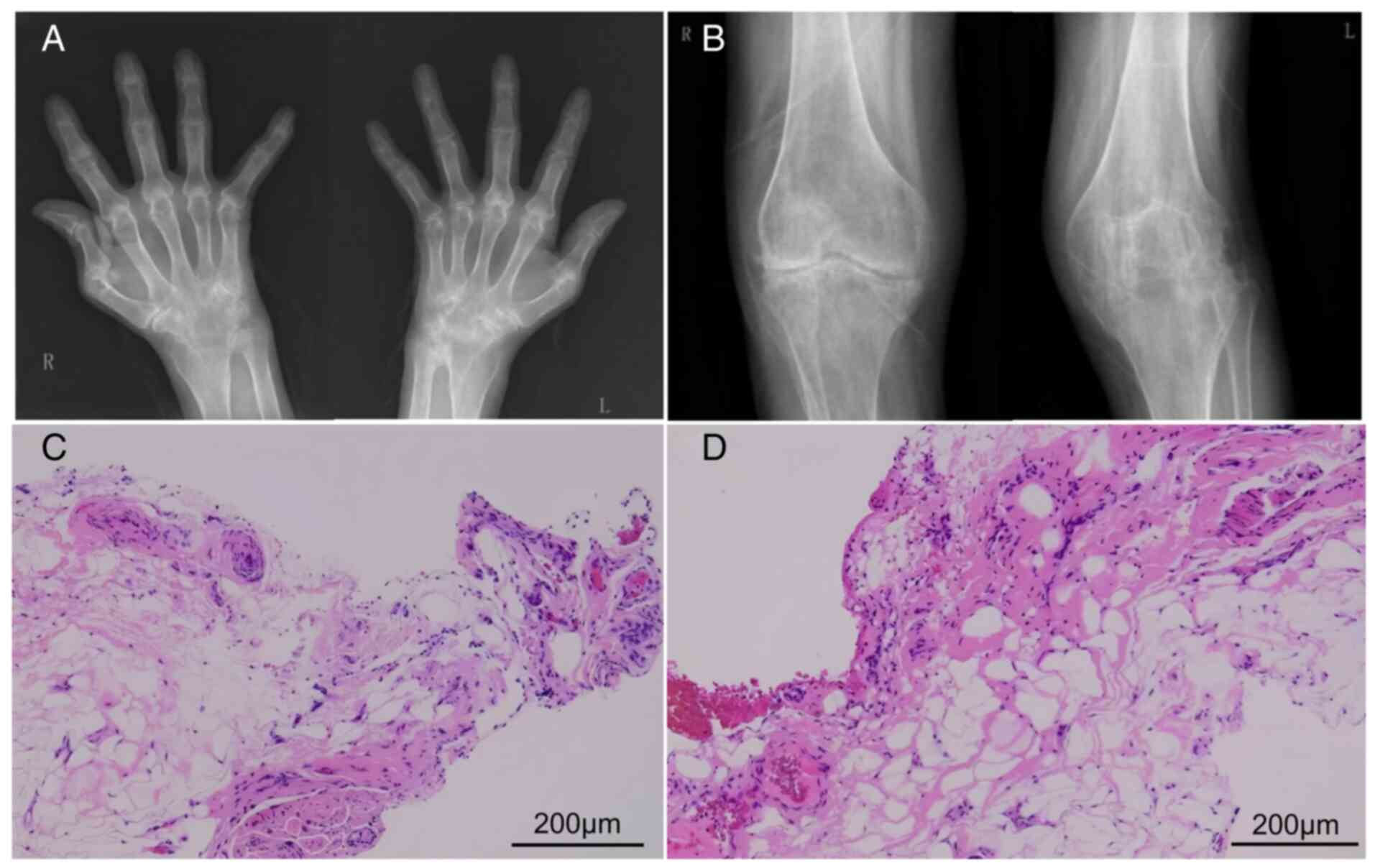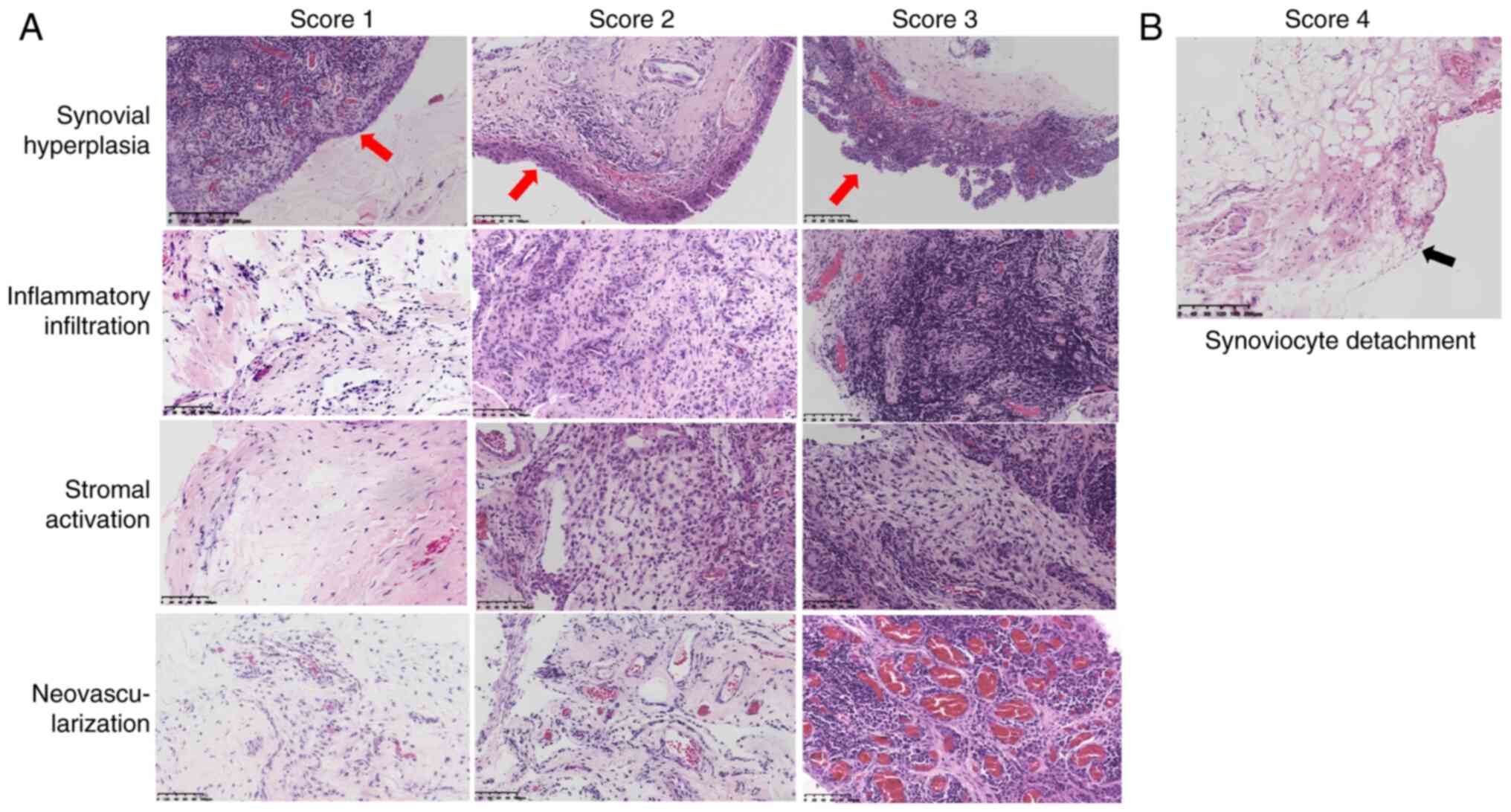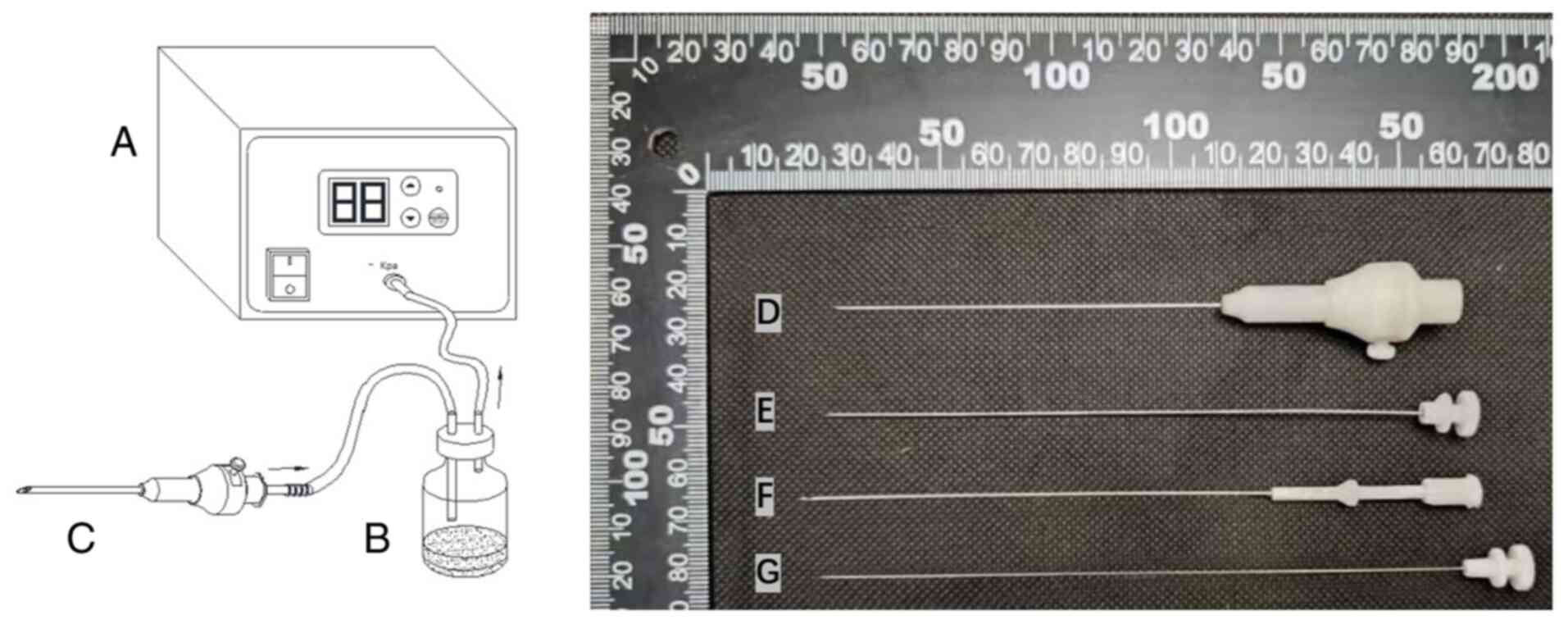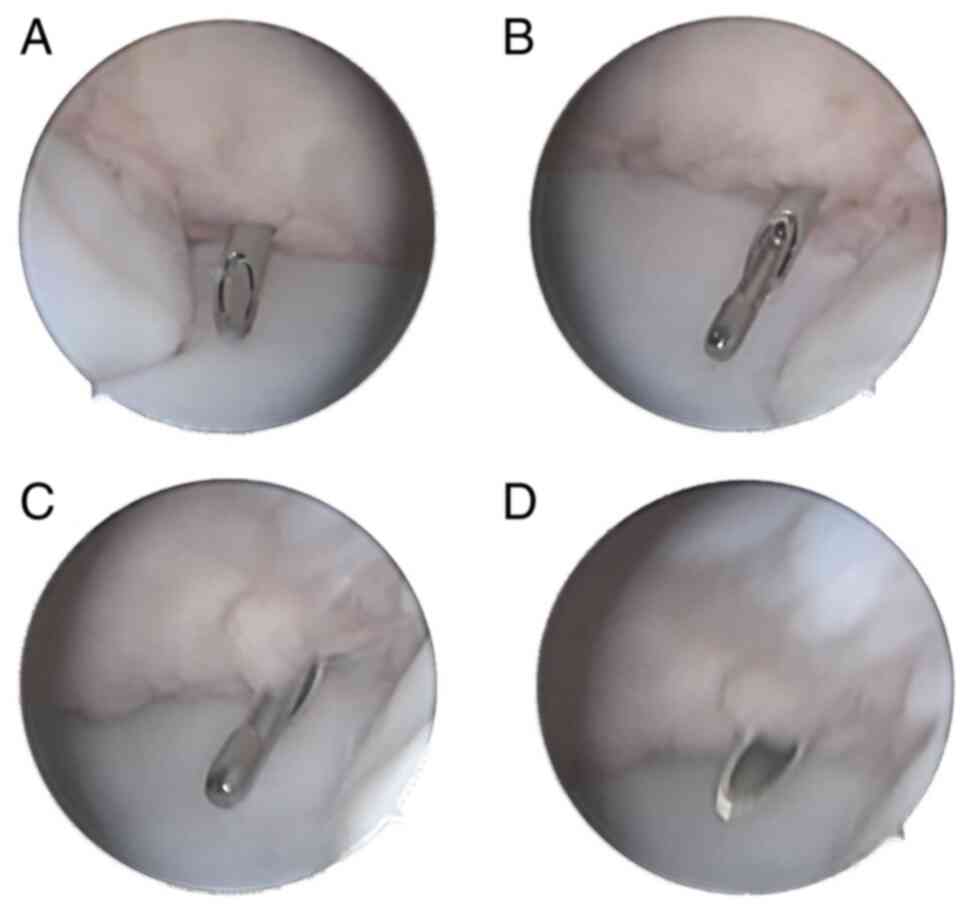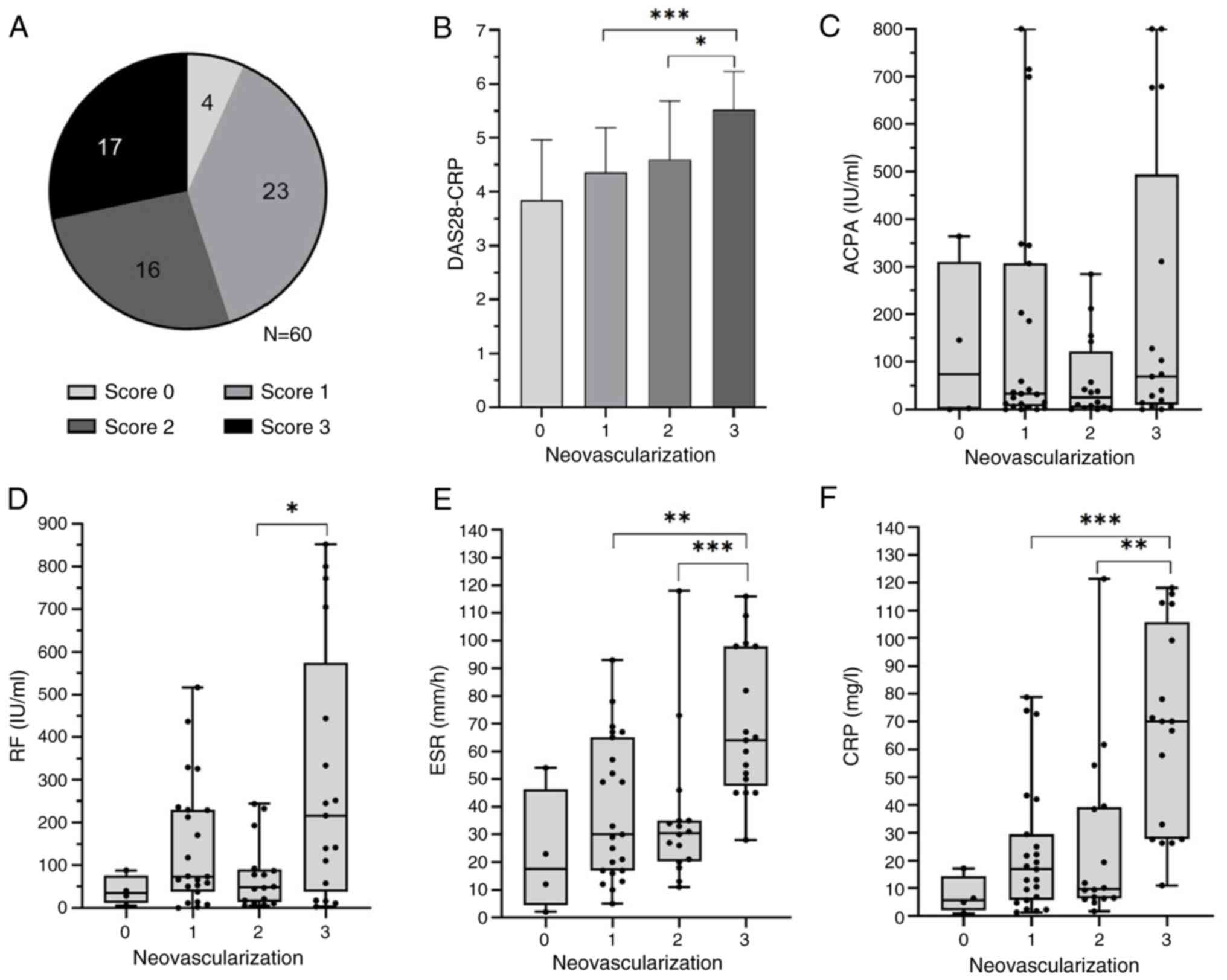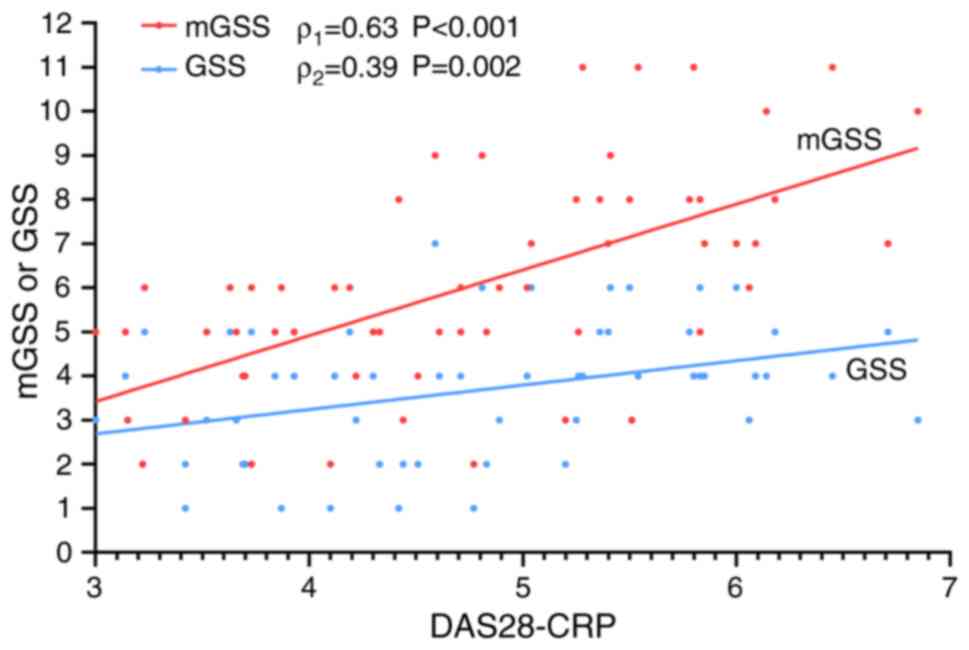Refining synovial inflammation assessment: A modified General Synovitis Score for active rheumatoid arthritis
- Authors:
- Published online on: January 24, 2025 https://doi.org/10.3892/etm.2025.12808
- Article Number: 58
-
Copyright: © Wu et al. This is an open access article distributed under the terms of Creative Commons Attribution License.
Abstract
Introduction
Rheumatoid arthritis (RA) is a chronic autoimmune disease that significantly impacts global health and affects ~1% of the population (1). This disease is characterized by persistent synovitis, which progressively destroys joint structures and results in substantial loss of function. Effective management of synovitis, the primary pathological manifestation of RA, is crucial for preventing joint erosion and mitigating disability in patients (2).
Histopathological examination of synovial biopsies remains the most direct method of assessing the severity of synovitis. The General Synovitis Score (GSS) is a widely used literature-supported method for scoring synovial inflammation based on histopathological changes observed in the synovium with hematoxylin and eosin (H&E) staining (3). It primarily evaluates three aspects: Synovial hyperplasia, stromal activation and inflammatory infiltration. Each aspect is semi-quantitatively scored from 0-3, with a total score >4 indicating inflammatory arthritis. Previous studies have confirmed a definite correlation between the GSS and the activity level of RA (4,5).
Studies of the histopathological features of the synovium in patients with RA have consistently found that the synovium exhibits characteristic features, including synovial hyperplasia, stromal activation, inflammatory infiltration, neovascularization and ectopic lymphoid neogenesis (6-8). However, the GSS omits one of the most crucial histopathological features of the RA synovium: Neovascularization. This omission may result in the GSS failing to fully capture the inflammatory characteristics of the RA synovium.
Observations at the Rheumatology and Immunology Department of the First Affiliated Hospital of Nanchang University (Nanchang, China) on RA synovial pathology have revealed that most patients exhibit varying degrees of neovascularization. Although synovial hyperplasia is widely acknowledged as a hallmark pathological change in almost all RA cases (8,9), some patients with RA exhibit thinning of the synovial lining, a decrease in the number of synoviocytes, loosening of the arrangement, or even complete synovial disappearance. This phenomenon is referred to as synoviocyte detachment. Patients with synoviocyte detachment typically have high levels of inflammatory markers, indicating increased disease activity (10). In such cases, the GSS often fails to accurately reflect disease activity. For example, in the present study, one RA patient with moderate to severe disease activity had a GSS of only 1 (Fig. 1).
To address this problem, the present study added neovascularization and synoviocyte detachment to the GSS items, resulting in an enhanced scoring system: The modified GSS (mGSS). This system semi-quantitatively assesses five key aspects of RA synovitis: Synovial hyperplasia, synoviocyte detachment, stromal activation, inflammatory infiltration and neovascularization (Fig. 2).
The present cross-sectional study was conducted to demonstrate the efficacy and reliability of the mGSS in assessing RA synovitis. The present study investigated the association of synovial neovascularization and synoviocyte detachment with disease activity in patients with RA and compared the correlations of the GSS and the mGSS with clinical disease activity.
Patients and methods
Patients
Between March 2023 and December 2023, 60 patients diagnosed with RA who underwent synovial biopsy at the Rheumatology and Immunology Department of The First Affiliated Hospital of Nanchang University (Nanchang, China) were enrolled. All patients met the 2010 American College of Rheumatology/European Alliance of Associations for Rheumatism diagnostic criteria for RA (11). The present study was approved by the Ethical Review Board of The First Affiliated Hospital of Nanchang University [ethics approval number IIT (2023); clinical ethics review no. 011]. Written informed consent was obtained from all patients before they underwent synovial biopsy. Clinical data, including sex, age, disease duration, medication history, anti-citrullinated protein antibody (ACPA), rheumatoid factor (RF), erythrocyte sedimentation rate (ESR), C-reactive protein (CRP), Tender 28-Joint Count (TJC-28), Swollen 28-Joint Count (SJC-28) and patient global assessment (PGA) were collected (12). The disease activity score in 28 joints CRP (DAS28-CRP)=0.56 x TJC-28 + 0.28 x SJC-28+ 0.36 x ln (CRP + 1) + 0.014 x PGA + 0.96.
Synovial biopsy and tissue processing
A novel synovial biopsy device was used in the present study (Fig. 3). A negative-pressure device was attached to the synovial biopsy needle to assist in capturing synovial tissue. The needle biopsy process is illustrated in Fig. 4. The biopsy sites were distributed as follows: 45 knee joints (75.0%), nine wrist joints (15.0%), two elbow joints (3.3%) and four ankle joints (6.7%). A total of six fragmented synovial pieces, each measuring ~3x6 mm, were obtained from the joint of each patient. These samples were fixed in 10% formalin with 0.01 mol/l phosphate buffer at room temperature (20-25˚C) for 24 h. Fixed samples were dehydrated through a graded ethanol series, cleared in xylene and embedded in molten paraffin wax at 60˚C. The paraffin-embedded tissues were sectioned at a thickness of 4 µm. H&E staining of sections was performed and the samples were examined under light microscopy (objective lens 10x). The sections were stained with hematoxylin (1%) at room temperature (~25˚C) for 8 min, differentiated for 5 sec, blued for 30 sec and counterstained with eosin (1%) for 2 min at room temperature. The slides were independently reviewed by two experienced histopathologists and disagreements were referred for further evaluation by a senior specialist.
Histopathology assessment
Histopathological examination assessed synovial lining hyperplasia, stromal activation, inflammatory infiltration and neovascularization, with each aspect scored semi-quantitatively from 0-3. Synoviocyte detachment was scored as 4. The GSS includes synovial lining hyperplasia, stromal activation and inflammatory infiltration, with a total score ranging from 0-9. The mGSS incorporates synovial hyperplasia (0-3) or synoviocyte detachment (4), stromal activation (0-3), neovascularization (0-3) and inflammatory infiltration (0-3), resulting in a total score ranging from 0-13 (Fig. 2). Synovial hyperplasia, stromal activation and inflammatory infiltration were scored as per the GSS (13).
As for neovascularization, both Tak et al (14) and de Bois et al (15) assessed the severity of neovascularization by evaluating vascular density, using the number of blood vessels counted under high-power fields and defining thresholds at 3, 9, 16 and 22. Inspired by this methodology, the present study adopted a similar approach and found it effective. Specifically, neovascularization was scored based on the number of blood vessels in synovial tissue, using the following criteria: 0: 0-3; 1: 4-9; 2: 10-15; 3: ≥16 vessels per field under a 20x objective lens using light microscopy. For this scoring system, capillaries, venules and arterioles were equally weighted to ensure a comprehensive evaluation.
Statistical analysis
Statistical analyses were performed using SPSS 26.0 (IBM Corp.). The normality of the data distribution was assessed using the Kolmogorov-Smirnov test. Normally distributed continuous data are presented as the mean (standard deviation). Unpaired two-tailed Student's t-test was used to analyze the differences between two normally distributed groups. Categorical data such as sex are presented as the number of subjects (percentage). For comparisons between two groups, the Mann-Whitney U test was applied for non-normally distributed data. For comparisons involving more than two groups, one-way ANOVA was applied for normally distributed continuous data, followed by Bonferroni's post hoc test. For non-normally distributed data, the Kruskal-Wallis test was used, with Dunn's post hoc test for multiple comparisons. Parametric data underwent correlation analyses using Spearman's correlation coefficient. P<0.05 was considered to indicate a statistically significant difference.
Results
Demographic and disease characteristics of all patients
The baseline characteristics of the 60 patients enrolled in the present study are summarized in Table I. Among the patients, 53 (88.3%) were female, with a mean age of 53.9 years and a mean disease duration of 97.6 months. Serological tests indicated that 38 (63.3%) patients were ACPA-positive and 45 (75.0%) were RF-positive. The mean DAS28-CRP score was 4.71±1.02.
Correlation between synovial neovascularization and clinical activity in patients with RA
The synovial histopathology of the 56 patients with RA (93.3%) had varying degrees of neovascularization. Among these, 23 had mild neovascularization (score, 1), 16 had moderate neovascularization (score, 2) and 17 had severe neovascularization (score, 3) (Fig. 5A). Patients with severe neovascularization had significantly higher DAS28-CRP, ESR and CRP levels than those with mild or moderate neovascularization (P<0.05) (Fig. 5B, E and F). However, no significant statistical difference was observed in ACPA levels across the mild, moderate and severe neovascularization groups (Fig. 5C). The mean RF level in patients with severe neovascularization was higher than that in patients with moderate neovascularization (P<0.05; Fig. 5D). The severity of neovascularization was significantly correlated with DAS28-CRP, ESR and CRP levels (all P<0.001) with correlation coefficients of 0.49, 0.44 and 0.51, respectively (Table II).
Table IICorrelation between synovial neovascularization and disease activity indicators in patients with rheumatoid arthritis. |
Comparison of disease activity in patients with synoviocyte proliferation and synoviocyte detachment
Among the patients, 36 (60%) had synoviocyte proliferation, with DAS28-CRP scores ranging from 1.88-5.88. A total of nine patients (16%) had synoviocyte detachment, corresponding to DAS28-CRP scores ranging from 3.75-5.89. The group with synoviocyte detachment had higher levels of ESR, CRP and DAS28-CRP compared with patients with synovial hyperplasia (P<0.05; Table III).
Table IIIComparison of clinical characteristics between patients with rheumatoid arthritis and with synoviocyte detachment and those with synoviocyte proliferation. |
Comparison of the correlations of DAS28-CRP between GSS and mGSS
Spearman's correlation analysis revealed that the GSS and the mGSS were significantly correlated with the DAS28-CRP level (Fig. 6). However, the mGSS had a stronger correlation (ρ=0.63; P<0.001) than the GSS (ρ=0.39; P=0.002).
Discussion
Neovascularization is considered to be an early and key event in the formation and maintenance of synovial inflammation in RA (16). Persistent inflammation increases oxygen demand, leading to local hypoxia, which induces the expression of pro-angiogenic factors, such as vascular endothelial growth factor (VEGF). This stimulates the formation of new blood vessels, provides oxygen and nutrients to proliferating synovial cells and facilitates inflammatory cell infiltration, thereby exacerbating chronic synovial inflammation (17,18). The increased endothelial surface area also creates a substantial capacity for producing cytokines, adhesion molecules and other inflammatory stimuli. Additionally, the proliferation of new blood vessels in the synovium facilitates tissue invasion, supporting the active infiltration of the synovium into the cartilage, leading to erosion and destruction of the cartilage (19,20).
In a previous study, the serum VEGF level was revealed to be higher in patients with RA than in healthy individuals. Furthermore, the serum VEGF level was correlated with ESR, CRP, RF, the number of tender and swollen joints, Modified Health Assessment Questionnaire and PGA of disease activity in patients with RA (21). Another study revealed that the serum VEGF level at presentation in patients with early RA was significantly correlated with the development of radiographic damage after 1 year, and improvement in the clinical symptoms of RA was associated with a reduced serum VEGF level (22). These findings highlight the pivotal role of neovascularization in fueling the progression and severity of RA. However, by inhibiting neovascularization, particularly through blocking the VEGF signaling pathway, synovial vascular density can be reduced, inflammatory cell infiltration decreased and symptoms alleviated (7,23).
In the present study, >90% of the patients with RA exhibited varying degrees of neovascularization. The synovial neovascularization score was significantly correlated with disease activity (DAS28-CRP) and the inflammatory markers, ESR and CRP. This indicates the widespread presence of synovial vascular lesions in RA histopathology and a strong association between increased neovascularization and heightened disease activity in patients with RA. Therefore, these results suggested that neovascularization may be a crucial parameter for assessing disease activity in patients with RA.
Another notable feature of RA synovium is synovial hyperplasia. The normal synovial lining consists of 2-3 layers of synoviocytes. However, in RA, chronic inflammation and aberrant cellular signaling drive the excessive proliferation of synoviocytes, leading to a synovial lining that can expand to 6-10 layers (8,24). This hyperplasia promotes the development of invasive pannus tissue and exacerbates joint damage (25). Consistent with previous studies, the current study found that most patients with RA (60%) had synovial hyperplasia. However, it was observed that some patients with RA did not have synovial hyperplasia and synoviocyte proliferation; by contrast, 16% of the patients had thinning of the synovial lining with synoviocyte detachment.
Physiopathological observations suggest that chronic mild inflammation typically leads to cell proliferation, whereas severe acute inflammation can result in cell necrosis and detachment (26,27). Substantial evidence indicates that chronic persistent inflammation within the synovial membrane leads to synoviocyte proliferation in RA (28). The mechanisms underlying synoviocyte proliferation are multifaceted and include the effects of inflammatory mediators, oxidative-stress-induced DNA damage and the infiltration of bone marrow-derived cells (29,30).
However, long-term chronic inflammation also results in the release of various inflammatory mediators, including TNF-α, IL-1 and IL-6, which can induce apoptosis of synoviocytes (31,32). There are two types of synoviocytes: Macrophage-like synoviocytes and fibroblast-like synoviocytes (FLS), with FLS being the major component of the synovial lining layer. In the early stages of RA, FLS have enhanced proliferative and antiapoptotic capabilities, leading to synovial hyperplasia. However, in later stages, prolonged inflammatory stimulation and cellular metabolic stress may cause these cells to gradually lose their proliferative ability, resulting in synovial thinning (20,33). Thus, synoviocyte necrosis and detachment can occur in two scenarios: During severe inflammation or as a late-stage manifestation. The present study showed that patients with synoviocyte detachment had higher disease activity but did not have longer disease duration than patients with synoviocyte proliferation. Therefore, it was hypothesized that synoviocyte detachment is more closely associated with severe inflammation in patients with RA. Thus, it is proposed that in synovitis scoring, the presence of synoviocyte detachment should be assigned a score of 4, higher than the score of 3 for severe synovial hyperplasia.
In response to these findings, the present study proposed the mGSS, which includes assessments of neovascularization and synoviocyte detachment alongside traditional parameters. The correlation between the mGSS and DAS28-CRP showed a trend towards superiority over the GSS (correlation coefficient, 0.62 vs. 0.37). This suggested that the enhanced scoring system aligns more closely with the clinical realities of RA, offering a more comprehensive assessment tool that can improve disease management strategies.
The present study had some limitations. First, it was a single-center study with a relatively small sample size, which may affect the generalizability of the findings. Second, the local sampling from different sites during minimally invasive synovial biopsy, the selection of synovial histopathology sections and manual readings are susceptible to subjective bias, which may also lead to result bias. Future studies with larger sample sizes are required to ensure the objectivity and accuracy of the results.
In conclusion, although the GSS provides a fundamental framework for evaluating synovial inflammation, it does not fully encompass the intricate histopathology of RA. The mGSS, with its inclusion of neovascularization and synoviocyte detachment, offers a more detailed and clinically relevant evaluation of synovial histopathology. The present study not only highlighted the association of these histopathological features with RA activity, but also set the stage for future research to validate and refine the mGSS, potentially establishing a new standard for assessing and managing RA.
Acknowledgements
The authors would like to acknowledge Dr Xie Tian (Nanchang Jialin Medical Pathology Laboratory, Nanchang, China) for preparing the logistics of the project.
Funding
Funding: The present study was supported by the Foundation of Jiangxi Provincial Health Commission Science and Technology Project (grant no. SKJP220212536).
Availability of data and materials
The data generated in the present study may be requested from the corresponding author.
Authors' contributions
DW and YD analyzed the data and drafted the initial manuscript. YH, JZ and WL collected the data and confirm the authenticity of all the raw data. YP and ZX independently assessed the pathological slides of the synovium. RW oversaw the entire project, designed the experiment and revised the manuscript draft. All authors read and approved the final manuscript.
Ethics approval and consent to participate
The present study was approved by the Ethical Review Board of the First Affiliated Hospital of Nanchang University [approval no. IIT (2023); clinical ethics review no. 011]. Written informed consent was obtained from all patients/participants, covering both their participation in the procedure and their participation in the study. All procedures were conducted in accordance with The Declaration of Helsinki (as revised in 2013).
Patient consent for publication
Not applicable.
Competing interests
The authors declare that they have no competing interests.
References
|
Smolen JS, Aletaha D and Mcinnes IB: Rheumatoid arthritis. Lancet. 388:2023–2038. 2016.PubMed/NCBI View Article : Google Scholar | |
|
Radu AF and Bungau SG: Management of rheumatoid arthritis: An overview. Cells. 10(2857)2021.PubMed/NCBI View Article : Google Scholar | |
|
Krenn V, Perino G, Rüther W, Krenn VT, Huber M, Hügle T, Najm A, Müller S, Boettner F, Pessler F, et al: 15 years of the histopathological synovitis score, further development and review: A diagnostic score for rheumatology and orthopaedics. Pathol Res Pract. 213:874–881. 2017.PubMed/NCBI View Article : Google Scholar | |
|
Schmidt T, Najm A, Mussawy H, Burghardt R, Oehler N, Krenn V, Rüther W and Niemeier A: General synovitis score and immunologic synovitis score reflect clinical disease activity in patients with advanced stage rheumatoid arthritis. Sci Rep. 9(8448)2019.PubMed/NCBI View Article : Google Scholar | |
|
Slansky E, Li J, Häupl T, Morawietz L, Krenn V and Pessler F: Quantitative determination of the diagnostic accuracy of the synovitis score and its components. Histopathology. 57:436–443. 2010.PubMed/NCBI View Article : Google Scholar | |
|
Szekanecz Z, Besenyei T, Szentpétery A and Koch AE: Angiogenesis and vasculogenesis in rheumatoid arthritis. Curr Opin Rheumatol. 22:299–306. 2010.PubMed/NCBI View Article : Google Scholar | |
|
Leblond A, Allanore Y and Avouac J: Targeting synovial neoangiogenesis in rheumatoid arthritis. Autoimmun Rev. 16:594–601. 2017.PubMed/NCBI View Article : Google Scholar | |
|
Henderson B, Revell PA and Edwards JC: Synovial lining cell hyperplasia in rheumatoid arthritis: Dogma and fact. Ann Rheum Dis. 47:348–349. 1988.PubMed/NCBI View Article : Google Scholar | |
|
Orr C, Vieira-Sousa E, Boyle DL, Buch MH, Buckley CD, Cañete JD, Catrina AI, Choy EHS, Emery P, Fearon U, et al: Synovial tissue research: A state-of-the-art review. Nat Rev Rheumatol. 13:463–475. 2017.PubMed/NCBI View Article : Google Scholar | |
|
Wang B, Li J, Huang Y and Wu R: Synoviocyte detachment: An overlooked yet crucial histological aspect in rheumatoid arthritis. BMC Musculoskelet Disord. 25(829)2024.PubMed/NCBI View Article : Google Scholar | |
|
Aletaha D and Smolen JS: Diagnosis and management of rheumatoid arthritis: A review. JAMA. 320:1360–1372. 2018.PubMed/NCBI View Article : Google Scholar | |
|
Van Riel PL and Renskers L: The disease activity score (DAS) and the disease activity score using 28 joint counts (DAS28) in the management of rheumatoid arthritis. Clin Exp Rheumatol. 34 (Suppl 5):S40–S44. 2016.PubMed/NCBI | |
|
Krenn V, Morawietz L, Burmester GR, Kinne RW, Mueller-Ladner U, Muller B and Haupl T: Synovitis score: Discrimination between chronic low-grade and high-grade synovitis. Histopathology. 49:358–364. 2006.PubMed/NCBI View Article : Google Scholar | |
|
Tak PP, Thurkow EW, Daha MR, Kluin PM, Smeets TJ, Meinders AE and Breedveld FC: Expression of adhesion molecules in early rheumatoid synovial tissue. Clin Immunol Immunopathol. 77:236–242. 1995.PubMed/NCBI View Article : Google Scholar | |
|
De Bois MH, Arndt JW, Tak PP, Kluin PM, van der Velde EA, Pauwels EK and Breedveld FC: 99Tcm-labelled polyclonal human immunoglobulin G scintigraphy before and after intra-articular knee injection of triamcinolone hexacetonide in patients with rheumatoid arthritis. Nucl Med Commun. 14:883–887. 1993.PubMed/NCBI View Article : Google Scholar | |
|
Szekanecz Z, Besenyei T, Paragh G and Koch AE: Angiogenesis in rheumatoid arthritis. Autoimmunity. 42:563–573. 2009.PubMed/NCBI View Article : Google Scholar | |
|
Taylor PC and Sivakumar B: Hypoxia and angiogenesis in rheumatoid arthritis. Curr Opin Rheumatol. 17:293–298. 2005.PubMed/NCBI View Article : Google Scholar | |
|
Konisti S, Kiriakidis S and Paleolog EM: Hypoxia-a key regulator of angiogenesis and inflammation in rheumatoid arthritis. Nat Rev Rheumatol. 8:153–162. 2012.PubMed/NCBI View Article : Google Scholar | |
|
Pober JS and Sessa WC: Evolving functions of endothelial cells in inflammation. Nat Rev Immunol. 7:803–815. 2007.PubMed/NCBI View Article : Google Scholar | |
|
Bottini N and Firestein GS: Duality of fibroblast-like synoviocytes in RA: Passive responders and imprinted aggressors. Nat Rev Rheumatol. 9:24–33. 2013.PubMed/NCBI View Article : Google Scholar | |
|
Lee SS, Joo YS, Kim WU, Min DJ, Min JK, Park SH, Cho CS and Kim HY: Vascular endothelial growth factor levels in the serum and synovial fluid of patients with rheumatoid arthritis. Clin Exp Rheumatol. 19:321–324. 2001.PubMed/NCBI | |
|
Ballara S, Taylor PC, Reusch P, Marmé D, Feldmann M, Maini RN and Paleolog EM: Raised serum vascular endothelial growth factor levels are associated with destructive change in inflammatory arthritis. Arthritis Rheum. 44:2055–2064. 2001.PubMed/NCBI View Article : Google Scholar | |
|
Zhao H, Duan S, Shi Y, Zhang M, Zhang L, Jin Z, Fu W, Xiao W, Bai T, Zhang X and Wang Y: Naru-3 inhibits inflammation, synovial hyperplasia and neovascularization in collagen-induced arthritis in rats. J Ethnopharmacol. 311(116350)2023.PubMed/NCBI View Article : Google Scholar | |
|
Tsubaki T, Arita N, Kawakami T, Shiratsuchi T, Yamamoto H, Takubo N, Yamada K, Nakata S, Yamamoto S and Nose M: Characterization of histopathology and gene-expression profiles of synovitis in early rheumatoid arthritis using targeted biopsy specimens. Arthritis Res Ther. 7:R825–R836. 2005.PubMed/NCBI View Article : Google Scholar | |
|
Liu H, Zhu Y, Gao Y, Qi D, Zhao L, Zhao L, Liu C, Tao T, Zhou C, Sun X, et al: NR1D1 modulates synovial inflammation and bone destruction in rheumatoid arthritis. Cell Death Dis. 11(129)2020.PubMed/NCBI View Article : Google Scholar | |
|
Federico A, Morgillo F, Tuccillo C, Ciardiello F and Loguercio C: Chronic inflammation and oxidative stress in human carcinogenesis. Int J Cancer. 121:2381–2386. 2007.PubMed/NCBI View Article : Google Scholar | |
|
Varela ML, Mogildea M, Moreno I and Lopes A: Acute inflammation and metabolism. Inflammation. 41:1115–1127. 2018.PubMed/NCBI View Article : Google Scholar | |
|
Liu F, Feng XX, Zhu SL, Huang HY, Chen YD, Pan YF, June RR, Zheng SG and Huang JL: Sonic hedgehog signaling pathway mediates proliferation and migration of fibroblast-like synoviocytes in rheumatoid arthritis via MAPK/ERK signaling pathway. Front Immunol. 9(2847)2018.PubMed/NCBI View Article : Google Scholar | |
|
Ma C, Wang J, Hong F and Yang S: Mitochondrial dysfunction in rheumatoid arthritis. Biomolecules. 12(1216)2022.PubMed/NCBI View Article : Google Scholar | |
|
Fearon U, Hanlon MM, Floudas A and Veale DJ: Cellular metabolic adaptations in rheumatoid arthritis and their therapeutic implications. Nat Rev Rheumatol. 18:398–414. 2022.PubMed/NCBI View Article : Google Scholar | |
|
Firestein GS and Mcinnes IB: Immunopathogenesis of rheumatoid arthritis. Immunity. 46:183–196. 2017.PubMed/NCBI View Article : Google Scholar | |
|
Firestein GS, Nguyen K, Aupperle KR, Yeo M, Boyle DL and Zvaifler NJ: Apoptosis in rheumatoid arthritis: p53 overexpression in rheumatoid arthritis synovium. Am J Pathol. 149:2143–2151. 1996.PubMed/NCBI | |
|
Taghadosi M, Adib M, Jamshidi A, Mahmoudi M and Farhadi E: The p53 status in rheumatoid arthritis with focus on fibroblast-like synoviocytes. Immunol Res. 69:225–238. 2021.PubMed/NCBI View Article : Google Scholar |



